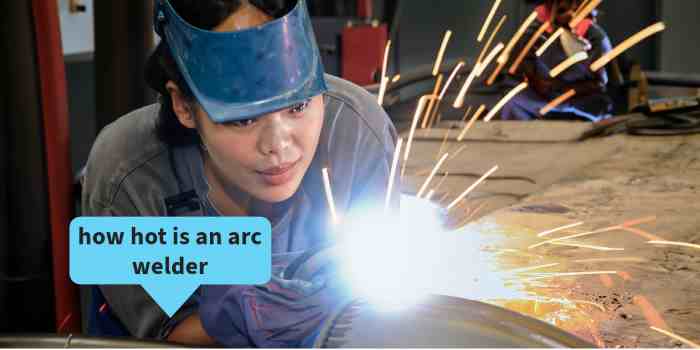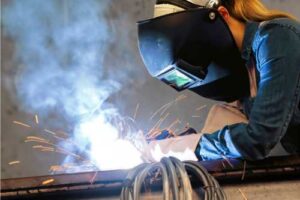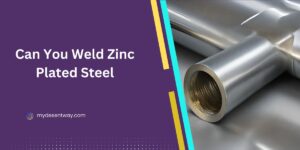Table of Contents
- How Hot is an Arc Welder?
- The Basics of Arc Welding
- Measuring Welding Temperatures
- Techniques for Temperature Control
- Safety Measures in Welding
- Achieving Optimal Welding Temperatures
- Overcoming Temperature-Related Challenges
- The Role of Welding Techniques
- Customization for Specific Applications
- The Future of Temperature Regulation
- Addressing Challenges in Temperature Control
- The Art of Welding Metallurgy
- Inclusive Welding Practices
- Striking an Arc with a Stick Welder – 5 Tips Every Beginner Needs to Know
- People also ask About How Hot is an Arc Welder
- Conclusion
- FAQs – How hot is an arc welder
When it comes to the world of welding, one question that often arises is, “How hot is an arc welder?” Welding is a crucial technique used in various industries, from construction to automotive, and understanding the temperatures involved is essential for ensuring a successful weld. In this article, we’ll delve into the temperatures produced by arc welders, the factors that influence these temperatures, and the techniques welders employ to achieve optimal results.
How Hot is an Arc Welder?
Arc welding involves the use of an electrical arc to generate intense heat that melts metals and allows them to fuse together. The temperatures reached during arc welding can vary depending on several factors, such as the type of metal being welded, the welding process used, and the specific welding parameters applied.
The temperature of an arc welder’s arc can range from approximately 6,000 to 25,000 degrees Fahrenheit (3,315 to 13,930 degrees Celsius). This extreme heat is necessary to melt the base metals and create a strong bond between them. However, it’s important to note that the actual temperature at the arc’s core is even higher, reaching temperatures comparable to the surface of the sun.
The Basics of Arc Welding
What is Arc Welding?
Arc welding is a process that involves joining metals by creating an electric arc between an electrode and the base material. This generates intense heat, melting the metals and allowing them to fuse together when they cool down.
The Role of Temperature
Temperature plays a pivotal role in arc welding, as it determines the quality and strength of the weld. The temperatures achieved during arc welding can vary widely based on factors such as the type of metal, the welding process, and the specific technique employed.
Measuring Welding Temperatures
Factors Influencing Temperatures
Several factors influence the temperatures produced by an arc welder:
- Type of Electrode: Different types of electrodes have varying heat levels. For example, electrodes with a thicker diameter tend to generate more heat than thinner ones.
- Welding Current: The amount of current passing through the electrode affects the heat intensity. Higher currents result in hotter welds.
- Base Metal: The type of metal being welded has a significant impact on the required temperature. Some metals have higher melting points than others.
Techniques for Temperature Control
Preheating and Post-Heating
In certain welding scenarios, preheating the base metal before welding can help achieve better results. Post-heating, which involves applying heat after welding, can relieve residual stresses and enhance the strength of the weld.
Welding Speed
Controlling the welding speed is a technique that impacts temperature regulation. A slower welding speed allows more heat to build up, while a faster speed can help prevent overheating.
Electrode Selection
Choosing the right electrode for the job is crucial. Different electrodes burn at different temperatures, affecting the overall heat of the weld.
Safety Measures in Welding
Protecting Against Heat
Given the extreme temperatures involved in arc welding, proper protective gear is essential. Welders must wear flame-resistant clothing, gloves, and a welding helmet with a shaded lens to shield their eyes from the intense light.
Adequate Ventilation
Welding produces not only intense heat but also hazardous fumes. Adequate ventilation is crucial to ensuring the safety of the welder and those in the vicinity.
Achieving Optimal Welding Temperatures
The Goldilocks Zone
Achieving the right temperature during arc welding is often likened to finding the “Goldilocks zone” – not too hot, not too cold, but just right. Welders aim to create a pool of molten metal that is fluid enough to fuse the materials together while maintaining the structural integrity of the metals involved.
Monitoring Techniques
Welders employ various methods to monitor and control temperatures:
- Visual Inspection: Experienced welders can gauge the temperature by observing the color of the arc and the molten pool. Different colors indicate different temperatures.
- Infrared Thermometers: These devices allow welders to measure the temperature of the base metal and the weld puddle accurately.
- Temperature Indicating Sticks: These sticks melt at specific temperatures, providing a visual cue to the welder regarding the heat levels.
Overcoming Temperature-Related Challenges
Avoiding Burn-Through
One challenge welders face is burn-through, where the heat becomes excessive and melts through the base metal. To prevent this, they must control the welding speed and adjust the current appropriately.
Minimizing Distortion
Excessive heat can lead to metal distortion during and after welding. Welders counteract this by using techniques like clamping and fixturing to control the shape of the metal as it cools.
The Role of Welding Techniques
Shielded Metal Arc Welding (SMAW)
SMAW, also known as stick welding, is a widely used arc welding technique. The electrode, coated in flux, generates a protective shield around the molten metal, controlling its exposure to the surrounding atmosphere and thus the heat generated.
Gas Metal Arc Welding (GMAW)
GMAW, or MIG welding, uses a continuous wire electrode and a shielding gas to protect the weld from atmospheric contamination. The controlled gas environment influences the temperature and overall quality of the weld.
Customization for Specific Applications
Tailoring for Different Materials
Different metals require different temperatures for optimal welding. Aluminum, for instance, has a lower melting point than steel, necessitating adjustments in welding technique and temperature.
Specialized Techniques
In certain applications, such as precision welding in aerospace, ultra-high temperatures are employed using techniques like electron beam welding. These techniques demand stringent control over temperature to achieve the desired results.
The Future of Temperature Regulation
Nanotechnology in Welding
As technology continues to advance, the use of nanomaterials is making its way into welding. Nanoparticles can enhance the properties of welds and offer better temperature control due to their unique thermal conductivity.
AI and Welding Automation
Artificial intelligence is playing a significant role in welding automation. AI-powered systems can analyze temperature data in real time, adjusting welding parameters to ensure precise temperature management and consistent weld quality.
Addressing Challenges in Temperature Control
Welding Dissimilar Materials
Welding metals with vastly different thermal conductivities can pose temperature-related challenges. Proper techniques, such as using intermediate materials or controlling heat input, are employed to prevent warping and cracking.
High-Temperature Alloys
Certain industries, like the aerospace and petrochemical sectors, require welding high-temperature alloys. These alloys are designed to withstand extreme temperatures, making temperature control during welding crucial to maintain their properties.
The Art of Welding Metallurgy
Phase Transformations
During welding, metals undergo phase transformations due to changes in temperature. Understanding these transformations helps welders predict the behavior of the metal and adjust their techniques accordingly.
Heat-Affected Zone (HAZ)
The HAZ is an area around the weld that experiences temperature changes during welding. Proper temperature control minimizes the size of the HAZ and prevents structural changes that could compromise the joint’s integrity.
Inclusive Welding Practices
Women in Welding
Traditionally male-dominated, the welding industry is seeing a rise in female welders. As the industry diversifies, it brings together a variety of perspectives and approaches to temperature control and welding techniques.
Accessibility and Inclusion
Efforts are being made to make welding education and careers accessible to individuals with disabilities. Adaptations and accommodations ensure that everyone interested in welding can contribute their skills to the field.
Striking an Arc with a Stick Welder – 5 Tips Every Beginner Needs to Know
People also ask About How Hot is an Arc Welder
How Hot is a Welding Arc in Celsius?
A welding arc is not to be taken lightly in terms of its temperature. It’s no ordinary flame; it’s a furnace of extreme heat. A typical welding arc can reach temperatures ranging from approximately 5,000 to 20,000 degrees Celsius. Yes, you read that right – we’re talking about temperatures that can rival the surface of the sun itself!
Is Arc Welding Hotter Than the Sun?
Arc welding might seem like a terrestrial affair, but its temperatures can actually give the sun a run for its money. While the sun’s core registers around 15 million degrees Celsius, the surface temperature hovers around a mere 5,500 degrees Celsius. On the other hand, certain welding arcs, especially those in processes like TIG (Tungsten Inert Gas) welding, can soar well above 10,000 degrees Celsius. So, in certain circumstances, arc welding can indeed outshine the sun’s surface temperature.
Unveiling the Heat of an Arc Welder
The heat produced by an arc welder is not only vital for fusing metals together, but it also showcases the immense energy at play. Arc welders generate heat through an electric arc formed between the workpiece and the welding electrode. This arc’s temperature can vary based on the welding process and the materials being joined. So, whether you’re wielding a stick welder or a sophisticated MIG (Metal Inert Gas) welder, the heat generated is a fundamental element in creating strong and durable welds.
How Hot is the Arc of a MIG Welder?
When it comes to MIG welding, the heat of the arc remains a pivotal factor. MIG welding employs a consumable wire electrode that continuously feeds into the weld pool, generating an arc that melts the wire and fuses it with the base metal. This results in a strong, consistent weld. The temperature of a MIG welding arc can range between 5,000 and 10,000 degrees Celsius, depending on the welding parameters and the materials involved.
Conclusion
In the world of welding, the question “How hot is an arc welder?” has a multifaceted answer. The temperatures generated can be incredibly high, but they can also be controlled and manipulated through various techniques. Welders must strike a balance between achieving the right temperature for a strong weld and ensuring safety.
FAQs – How hot is an arc welder
Q1. Is arc welding the hottest welding process?
Ans: Arc welding is one of the hottest welding processes, but others like laser welding can generate even higher temperatures.
Q2. Can welding temperatures cause metal deformation?
Ans: Yes, excessive heat can lead to metal distortion and deformation if not properly controlled.
Q3. What is the risk of overheating during welding?
Ans: Overheating can result in weakened welds, increased spattering, and potential damage to the base metal.
Q4. Are all metals welded at the same temperature?
Ans: No, different metals have different melting points, so the welding temperature needs to be adjusted accordingly.
Q5. Is there a way to cool down welds faster?
Ans: Yes, using proper post-heating and controlled cooling techniques can expedite the cooling process without compromising the weld’s integrity.









